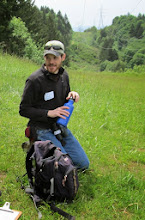For several decades, researchers in the Aleutian Islands have been documenting the major role sea otters play in structuring marine environments. They have found the sea otters eat a lot of sea urchins, which eat a lot of kelp. Where sea otters are present, underwater kelp forests thrive and create habitat for a variety of fish and invertebrates. When sea otters were extirpated during the previous century, the kelp forests and animals that depended on them disappeared. When sea otters returned, so did the kelp forests.

In their recently published paper in Ecology, Robert G. Anthony and others studied populations of bald eagles before and after a sea otter decline. They expected that the breeding population of eagles would decline as well because much of their nestlings’ diet is sea otters and other animals found in kelp forests.
Instead, they found that the breeding population remained stable and nest success did not decrease. Instead of declining, the eagles changed their diets. They responded to loss of kelp forests by hunting non-kelp fish and increasing the number of birds fed to their nestlings.
The two species of birds that saw the greatest increase in eagle predation were glaucous-winged gulls and rock ptarmigan. A great example of how changes to the population of one species can cascade up and down to other trophic levels and indirectly affect other species.
So save an otter, save a ptarmigan!
Work cited: Anthony, R. G., J. A. Estes, M. A. Ricca, A. K Miles, and E. D. Foresman. 2008. Bald eagles and sea otters in the Aleutian Archipelago: indirect effects of trophic cascades. Ecology 89(10): 2725-2735.








No comments:
Post a Comment